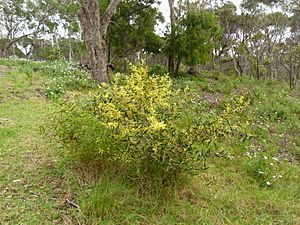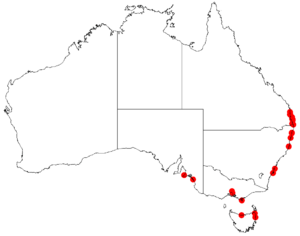Coastal wattle facts for kids
Quick facts for kids Coastal wattle |
|
|---|---|
 |
|
 |
|
| Fruit | |
| Scientific classification | |
| Genus: |
Acacia
|
| Species: |
sophorae
|
 |
|
| Occurrence data from AVH | |
| Synonyms | |
|
|
Acacia sophorae, often called coastal wattle or coast wattle, is a type of wattle tree. You can find it growing along the coasts and near-coastal areas of south-eastern Australia. It stretches from the Eyre Peninsula all the way up to southern Queensland. Sometimes, people think it's a special kind of sallow wattle (Acacia longifolia). Its scientific name, sophorae, comes from how similar it looks to plants in the Sophora family.
Contents
About the Coastal Wattle Plant
What Does Coastal Wattle Look Like?
The coastal wattle is usually a large shrub. This means it's a woody plant smaller than a tree. It often grows low to the ground, with its main stem and lower branches spreading out. It can reach about 3 meters (10 feet) tall. But it can also spread out more than 4 meters (13 feet) wide!
Its leaves are not typical flat leaves. Instead, they are oval-shaped phyllodes. These are flattened leaf stalks that act like leaves. They are usually 50 to 100 millimeters (2 to 4 inches) long. You can see clear lines, or veins, running along them.
Flowers and Where They Grow
The coastal wattle has bright yellow flowers. These flowers grow in long, thin spikes. Each spike can be up to 50 millimeters (2 inches) long. They appear where the phyllodes join the stem.
You'll mostly see these beautiful yellow flowers in late winter and during spring.
Where Does Coastal Wattle Live?
This plant loves coastal areas. You can find it growing on the first sand dunes right by the beach. It also lives in coastal heathlands, which are open areas with low shrubs. Sometimes, it grows in open forests and on flat areas made of river deposits.
How Coastal Wattle Helps the Environment
Coastal wattle is very useful for keeping beaches healthy. It's often planted to help stabilize sand dunes. This means it helps stop the sand from blowing away. It can handle harsh conditions like sea spray (salty water from the ocean) and strong winds carrying sand. By growing strong, it protects other plants that are not as tough.

